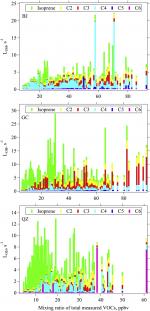Citation:

摘要:
To better understand the chemical speciation of volatile organic compounds (VOCs) and their role in ground-level ozone formation in the Beijing-Tianjin-Hebei region, China, measurements of 56 non-methane hydrocarbons (NMHCs) and 12 carbonyls were conducted at three sites in summer. Alkanes were the largest group of NMHCs (>50%), followed by alkenes and aromatics. Acetone was the most abundant carbonyl species (>50%). The OH loss rates (LOH) of VOCs were calculated to estimate their chemical reactivities. Alkenes played a predominant role in VOC reactivity, among which ethene and propene were the largest contributors. Isoprene contributed 11.61–38.00% of the total reactivity of measured VOCs. Alkenes and aromatics were the largest contributors (47.65–61.53% totally) to the total Ozone Formation Potential (OFP) of measured VOCs based on the observed mixing ratio. Isoprene was the most reactive species, but originated mainly from biogenic emissions. Ethene, m/p-xylene, toluene, propene, o-xylene, and 1-butene were considered to play significant roles in ground-level ozone formation in this region. The OFPs of total measured NMHCs increased by 10.20–22.05% when they were calculated based on the initial mixing ratio. Photochemical losses of hydrocarbons and the secondary formation of carbonyls in this region were also determined. Vehicle exhaust emissions contributed substantially to ambient VOCs.
